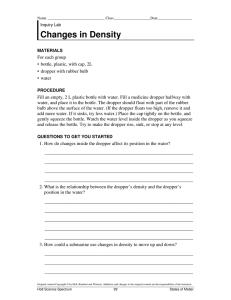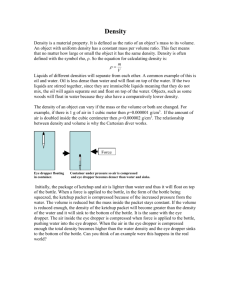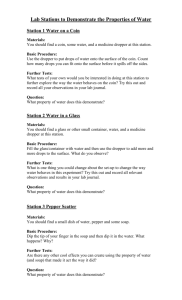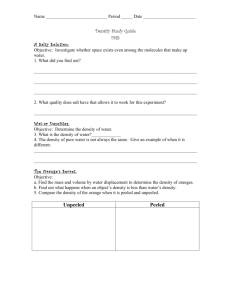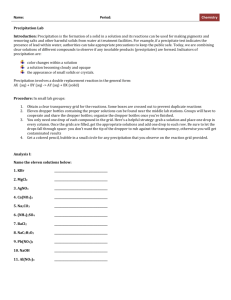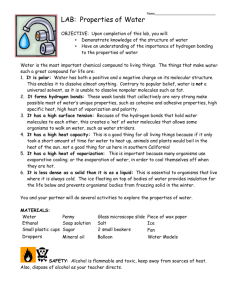Gas Law Demonstrations: Charles' & Boyle's Law Experiments
advertisement
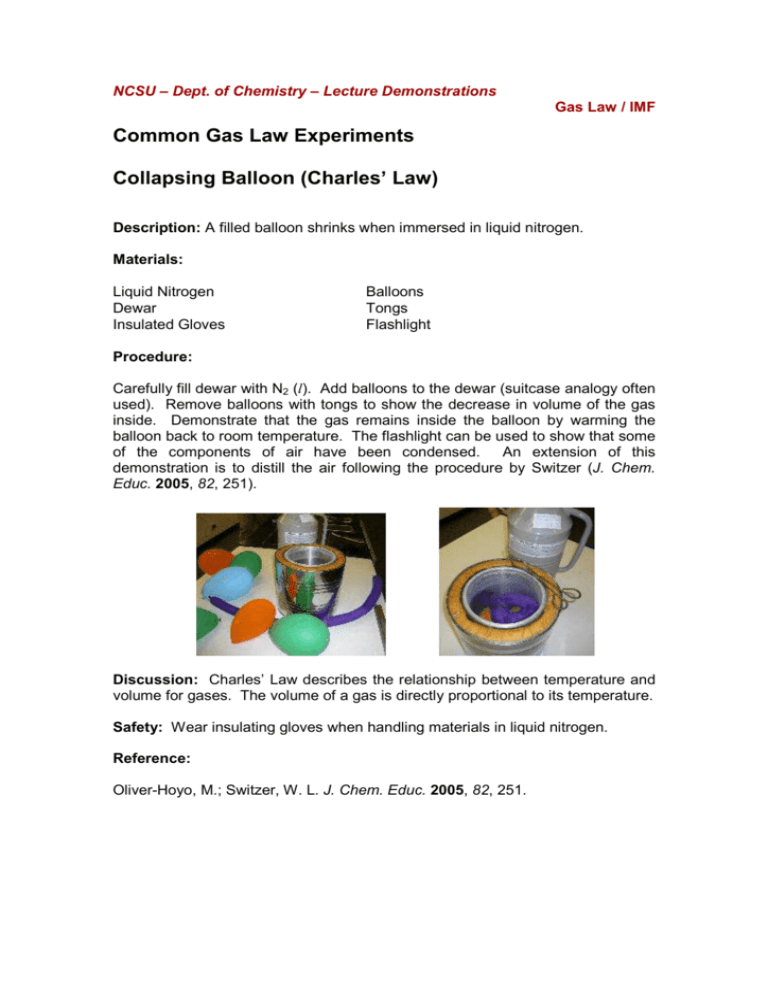
NCSU – Dept. of Chemistry – Lecture Demonstrations Gas Law / IMF Common Gas Law Experiments Collapsing Balloon (Charles’ Law) Description: A filled balloon shrinks when immersed in liquid nitrogen. Materials: Liquid Nitrogen Dewar Insulated Gloves Balloons Tongs Flashlight Procedure: Carefully fill dewar with N2 (l). Add balloons to the dewar (suitcase analogy often used). Remove balloons with tongs to show the decrease in volume of the gas inside. Demonstrate that the gas remains inside the balloon by warming the balloon back to room temperature. The flashlight can be used to show that some of the components of air have been condensed. An extension of this demonstration is to distill the air following the procedure by Switzer (J. Chem. Educ. 2005, 82, 251). Discussion: Charles’ Law describes the relationship between temperature and volume for gases. The volume of a gas is directly proportional to its temperature. Safety: Wear insulating gloves when handling materials in liquid nitrogen. Reference: Oliver-Hoyo, M.; Switzer, W. L. J. Chem. Educ. 2005, 82, 251. NCSU – Dept. of Chemistry – Lecture Demonstrations Gas Law / IMF Collapsing Metal Can (Boyle’s Law) Description: A metal can is crushed when immersed in cold water. Materials: Empty soda can Ice water Beaker Bunsen burner Procedure: Add 15 mL of water to aluminum can and bring to a vigorous boil. Quickly invert the can and submerge it into the beaker filled with ice. At this point the can will collapse. Alternatively, the same concept can be demonstrated by adding water to an Erlenmeyer flask, heating the water to a boil and quickly placing a balloon over the mouth of the flask. When the flask is then submerged in ice water the balloon collapses inside the flask. Discussion: Boyle’s Law describes the relationship between volume and pressure of gases. The volume of a gas varies inversely with its pressure. When the can is filled with water vapor, the pressure inside the can is greater than the pressure on the outside of the can. When immersed in water, the water seals the opening and the vapor inside the can condenses, thus reducing the pressure inside the can and causing the can to be crushed. Safety: Boiling water can cause burns. Use caution when working with an open flame. Reference: Shakhashiri, B. Z. In Chemical Demonstrations: A Handbook for Teachers of Chemistry; The University of Wisconsin Press: 1985; Vol. 2, p 6-8. Summerlin, L. R.; Ealy, J. L. In Chemical Demonstrations: A Sourcebook for Teachers; American Chemical Society: 1988; Vol. 2, p 26-27. Video: http://www.youtube.com/watch?v=ZGhAeG13MTI&feature=related http://www.youtube.com/watch?v=Uy-SN5j1ogk (55-gallon drum) NCSU – Dept. of Chemistry – Lecture Demonstrations Gas Law / IMF Peep Show (Boyle’s Law) Description: Objects with air trapped inside will expand when placed inside a vacuum chamber. Materials: Bell jar Vacuum pump Balloons, marshmallows Peeps, shaving cream, bag of chips Procedure: Place object inside bell jar. Turn on vacuum pump and observe the physical change in the object as air is removed from the bell jar. Turn off pump and return bell jar to atmospheric pressure observing again the change in size of the object. Discussion: Boyle’s Law describes the relationship between volume and pressure of gases. The volume of a gas varies inversely with its pressure. When the vacuum pump is turned on, air is removed from the bell jar thus reducing the external pressure around the object in the bell jar. As the external pressure is reduced, the volume of the gas within the object expands. Safety: Keep hands clear of vacuum pump while it is turned on. Reference: Shakhashiri, B. Z. In Chemical Demonstrations: A Handbook for Teachers of Chemistry; The University of Wisconsin Press: 1985; Vol. 2, p 12-13. Video: http://www.youtube.com/watch?v=lfNJJEdKgLU (Pierre and Marie) http://www.youtube.com/watch?v=RPlCO3AITV4&feature=related (shaving cream) NCSU – Dept. of Chemistry – Lecture Demonstrations Gas Law / IMF Cartesian Diver (Boyle’s Law) Description: A medicine dropper inside a bottle filled with water will float until pressure is applied to the bottle at which point it sinks. Boyle’s Law is applied in this demonstration. Materials: 2-L plastic bottle Medicine dropper Water Procedure: Fill a 2-L bottle with water and place an empty medicine dropper inside. Seal the bottle and squeeze the sides. Notice that the water level inside the dropper rises and the dropper will sink. At rest, the dropper floats. For younger audiences, have them believe at first that the dropper is being pulled by an invisible string, making the motion of pulling a string as the dropper sinks. Discussion: Boyle’s Law describes the relationship between pressure and volume for gases. According to this law, as pressure on the gas increases, the volume of space that the gas occupies will decrease. By squeezing the bottle the pressure on the air inside the medicine dropper is increased as water fills the dropper. The dropper becomes heavier and sinks. When the pressure is released, the opposite effect is observed and the dropper rises back to the top of the bottle. Reference: Pinkerton, K. D. J. Chem. Educ. 2001, 78, 200A. Thompson, J. U. S.; Goldsby, K. A. J. Chem. Educ. 1994, 71, 801. Video: http://www.youtube.com/watch?v=gFUdLEcm8qs&feature=related http://www.youtube.com/watch?v=JGo7ECXCNgs&feature=related NCSU – Dept. of Chemistry – Lecture Demonstrations Gas Law / IMF Gas Law Apparatus Description: The gas law apparatus demonstrates the relationships between volume and pressure and temperature and pressure of gases. Materials: Gas Law Apparatus (Dab 114) Warm water bath Liquid nitrogen Procedure: For large lecture halls, place apparatus on overhead projector. 1. To demonstrate the relationship between volume and pressure connect the glass syringe to the pressure gauge. Pushing the plunger into the syringe will decrease the volume of the gas inside the syringe and increase the pressure of the gas. The opposite occurs when the plunger is pulled out. Incremental changes in volume and the corresponding pressure change can be noted and plotted on a graph showing P vs. V. 2. To demonstrate the relationship between temperature and pressure connect the metal sphere to the pressure gauge. When placed in a warm bath, the pressure of the gas increases. When placed in a cold bath (dry ice/acetone, liquid nitrogen, and ice) the pressure decreases. The pressure differences between a warm bath (of known temp.), room temperature and a cold bath can be noted and plotted on a graph of T vs. V. From this graph, a crude extrapolation can be made to determine absolute zero. Discussion: The gas law apparatus clearly demonstrates that inverse volume and pressure are inversely proportional and that temperature and pressure are directly proportional. Safety: Boiling water can cause burns. Wear insulated gloves when handling liquid nitrogen.
